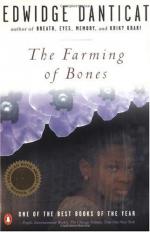|
This section contains 899 words (approx. 3 pages at 300 words per page) |

|
SOURCE: “No Room for the Living,” in New York Times Book Review, September 27, 1998.
In the following review, Upchurch offers a mixed assessment of The Farming of Bones.
Hallucinatory vigor and a sense of mission—these are what, in her best moments, the Haitian-American writer Edwidge Danticat brings to her sobering novel about “two different peoples trying to share one tiny piece of land.”
The setting is the border country of the Caribbean island of Hispaniola and the year is 1937, a place and time when the longstanding hostility between the Dominican Republic and its neighbor, Haiti, is about to erupt into bloodshed, carefully orchestrated by the Dominican dictator Rafael Trujillo Molina. But Amabelle Desir, the Haitian housemaid who is the novel's narrator, gives little credence to the rumors of imminent violence. Instead, her focus is on the worries of her immediate household.
Amabelle's Dominican mistress, Senora Valencia, is still...
|
This section contains 899 words (approx. 3 pages at 300 words per page) |

|


